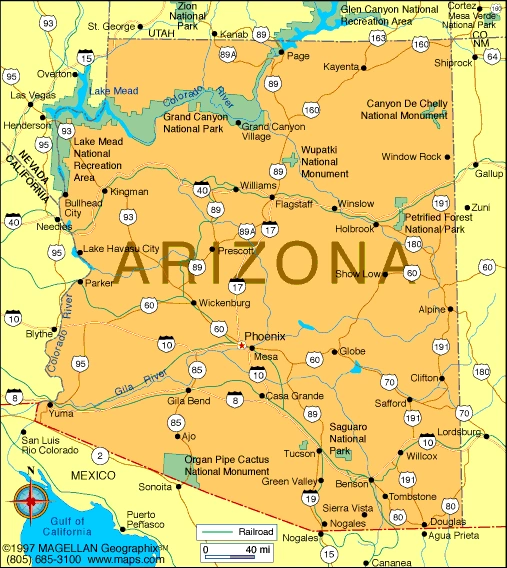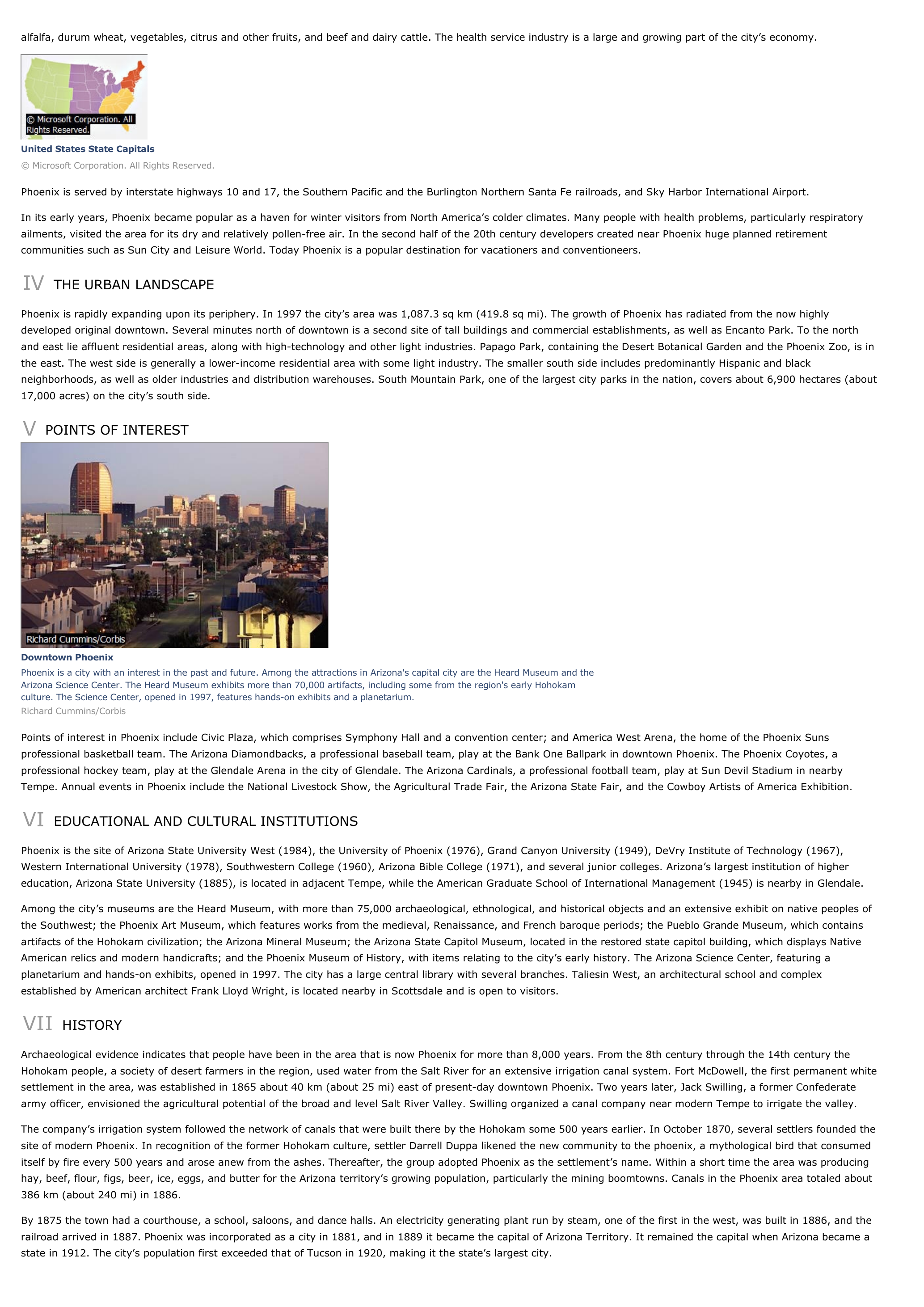Phoenix (city, Arizona) - geography.
Publié le 27/05/2013
Extrait du document


«
alfalfa, durum wheat, vegetables, citrus and other fruits, and beef and dairy cattle.
The health service industry is a large and growing part of the city’s economy.
United States State Capitals© Microsoft Corporation.
All Rights Reserved.
Phoenix is served by interstate highways 10 and 17, the Southern Pacific and the Burlington Northern Santa Fe railroads, and Sky Harbor International Airport.
In its early years, Phoenix became popular as a haven for winter visitors from North America’s colder climates.
Many people with health problems, particularly respiratoryailments, visited the area for its dry and relatively pollen-free air.
In the second half of the 20th century developers created near Phoenix huge planned retirementcommunities such as Sun City and Leisure World.
Today Phoenix is a popular destination for vacationers and conventioneers.
IV THE URBAN LANDSCAPE
Phoenix is rapidly expanding upon its periphery.
In 1997 the city’s area was 1,087.3 sq km (419.8 sq mi).
The growth of Phoenix has radiated from the now highlydeveloped original downtown.
Several minutes north of downtown is a second site of tall buildings and commercial establishments, as well as Encanto Park.
To the northand east lie affluent residential areas, along with high-technology and other light industries.
Papago Park, containing the Desert Botanical Garden and the Phoenix Zoo, is inthe east.
The west side is generally a lower-income residential area with some light industry.
The smaller south side includes predominantly Hispanic and blackneighborhoods, as well as older industries and distribution warehouses.
South Mountain Park, one of the largest city parks in the nation, covers about 6,900 hectares (about17,000 acres) on the city’s south side.
V POINTS OF INTEREST
Downtown PhoenixPhoenix is a city with an interest in the past and future.
Among the attractions in Arizona's capital city are the Heard Museum and theArizona Science Center.
The Heard Museum exhibits more than 70,000 artifacts, including some from the region's early Hohokamculture.
The Science Center, opened in 1997, features hands-on exhibits and a planetarium.Richard Cummins/Corbis
Points of interest in Phoenix include Civic Plaza, which comprises Symphony Hall and a convention center; and America West Arena, the home of the Phoenix Sunsprofessional basketball team.
The Arizona Diamondbacks, a professional baseball team, play at the Bank One Ballpark in downtown Phoenix.
The Phoenix Coyotes, aprofessional hockey team, play at the Glendale Arena in the city of Glendale.
The Arizona Cardinals, a professional football team, play at Sun Devil Stadium in nearbyTempe.
Annual events in Phoenix include the National Livestock Show, the Agricultural Trade Fair, the Arizona State Fair, and the Cowboy Artists of America Exhibition.
VI EDUCATIONAL AND CULTURAL INSTITUTIONS
Phoenix is the site of Arizona State University West (1984), the University of Phoenix (1976), Grand Canyon University (1949), DeVry Institute of Technology (1967),Western International University (1978), Southwestern College (1960), Arizona Bible College (1971), and several junior colleges.
Arizona’s largest institution of highereducation, Arizona State University (1885), is located in adjacent Tempe, while the American Graduate School of International Management (1945) is nearby in Glendale.
Among the city’s museums are the Heard Museum, with more than 75,000 archaeological, ethnological, and historical objects and an extensive exhibit on native peoples ofthe Southwest; the Phoenix Art Museum, which features works from the medieval, Renaissance, and French baroque periods; the Pueblo Grande Museum, which containsartifacts of the Hohokam civilization; the Arizona Mineral Museum; the Arizona State Capitol Museum, located in the restored state capitol building, which displays NativeAmerican relics and modern handicrafts; and the Phoenix Museum of History, with items relating to the city’s early history.
The Arizona Science Center, featuring aplanetarium and hands-on exhibits, opened in 1997.
The city has a large central library with several branches.
Taliesin West, an architectural school and complexestablished by American architect Frank Lloyd Wright, is located nearby in Scottsdale and is open to visitors.
VII HISTORY
Archaeological evidence indicates that people have been in the area that is now Phoenix for more than 8,000 years.
From the 8th century through the 14th century theHohokam people, a society of desert farmers in the region, used water from the Salt River for an extensive irrigation canal system.
Fort McDowell, the first permanent whitesettlement in the area, was established in 1865 about 40 km (about 25 mi) east of present-day downtown Phoenix.
Two years later, Jack Swilling, a former Confederatearmy officer, envisioned the agricultural potential of the broad and level Salt River Valley.
Swilling organized a canal company near modern Tempe to irrigate the valley.
The company’s irrigation system followed the network of canals that were built there by the Hohokam some 500 years earlier.
In October 1870, several settlers founded thesite of modern Phoenix.
In recognition of the former Hohokam culture, settler Darrell Duppa likened the new community to the phoenix, a mythological bird that consumeditself by fire every 500 years and arose anew from the ashes.
Thereafter, the group adopted Phoenix as the settlement’s name.
Within a short time the area was producinghay, beef, flour, figs, beer, ice, eggs, and butter for the Arizona territory’s growing population, particularly the mining boomtowns.
Canals in the Phoenix area totaled about386 km (about 240 mi) in 1886.
By 1875 the town had a courthouse, a school, saloons, and dance halls.
An electricity generating plant run by steam, one of the first in the west, was built in 1886, and therailroad arrived in 1887.
Phoenix was incorporated as a city in 1881, and in 1889 it became the capital of Arizona Territory.
It remained the capital when Arizona became astate in 1912.
The city’s population first exceeded that of Tucson in 1920, making it the state’s largest city..
»
↓↓↓ APERÇU DU DOCUMENT ↓↓↓
Liens utiles
- Phoenix (city, Arizona) - geography.
- Buenos Aires (city) - geography.
- Dublin (city, Ireland) - geography.
- Mexico City - geography.
- Moscow (city, Russia) - geography.

































